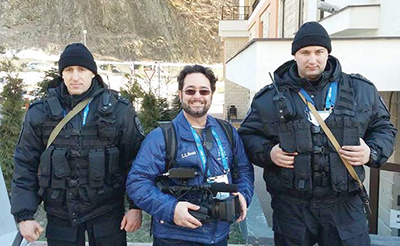Weather Channel Shoots for ‘4K in Four Years’
ATLANTA—“4K in Four Years”: That’s the slogan driving The Weather Channel team’s ambitious plans to fully convert to 4K content acquisition, production and distribution by 2018. And this slogan isn’t just marketing hype; The Weather Channel has already purchased Sony PXW-Z100 4K professional camcorders for ENG use, field-testing one of the cameras at the 2014 Sochi Olympics. Since May, five Z100a have been incorporated into The Weather Channel NextGEN ENG 4K field kits, for use in chasing tornadoes.

Flanked by Russian security officers, Matt Saffer, a producer with The Weather Channel, field-tested a Sony PXW-Z100 4K professional camcorder at the 2014 Sochi Olympics. “Even though The Weather Channel is over 30 years old, we see ourselves as a young, scrappy network focused on standing out from the pack,” said Phillip Grossman, senior director of media technology and strategy for The Weather Channel in Atlanta. “We see 4K as the ‘next big thing,’ and it is our goal to be a leader among leaders in rolling out this technology— and attracting 4K TV set owners who are seeking 4K content to watch; just as HD early adopters did a decade ago.”
A GUTSY STRATEGY
The Weather Channel network’s 4K conversion is a gutsy end-to-end strategy; one that is being rolled out even as equipment manufacturers struggle to develop 4K technology that is truly broadcast-ready, affordable, and can integrate with each other’s equipment. In making the move, the network is also moving to 60 frames per second video, and upgrading from 8-bit to 10-bit color. By doing so, The Weather Channel plans to immerse its viewers directly into the weather they’re watching; enhancing their viewing experience so much that, compared to HD, they’ll keep tuning in for more.
“To achieve this goal, we see ourselves upgrading every single element of our production facility,” said Grossman. “Some upgrades will be easy. For instance, the Z100s are already available, while upgrading our editing capabilities will mean buying new Macs and high-end PCs with additional storage space. Others are not so simple: We’re still seeking 4K studio cameras, video switchers, and a 4K core router for producing and routing 4K in-house.”
Speaking of routing, The Weather Channel already has 40 miles of cable strung through its Atlanta facility. “We’ll have to either add to that or upgrade it—or both— to cope with the four-times-larger-than-HD bandwidth requirements of 4K video transport,” Grossman said. “This is not a small upgrade.”
SONY CAMERA PROVIDES MORE OPTIONS
Despite its 4K 60fps capabilities, the Sony PXW-Z100 4K camcorder only weighs 5.42 pounds; much less than an analog Betamax camcorder from days gone by. Add the ability to shoot in both 4K/60fps, 1080p/30fps, and a range of other formats, and the footage from the Z100s can be easily edited at The Weather Channel facilities today.
Because the Z100’s 4K footage delivers four times the resolution of HD, the footage being shot today provides the network’s shooters with a lot more options than conventional HD camcorders would. It also provides for an extra safety margin when shooting tornadoes for HD broadcasts.
Get the TV Tech Newsletter
The professional video industry's #1 source for news, trends and product and tech information. Sign up below.
“4K allows for long zooms without getting right up there in front of the subject,” Grossman explained. “When capturing tornadoes, our teams can stand away from the weather a little bit and still get the shot, which is crucial because the crew’s safety is our priority.”
Working in 4K for HD is also “helping our people to start thinking differently about what they shoot,” he said. “With 4K, you can frame something a bit wider and then do push-ins in post, or dual side-by-side interviews and be able to cut from one person to the other using the same image without needing multiple cameras. That’s great for us because, in the middle of a storm environment, you really can’t set up multiple cameras all the time.”
BANKING ON THE WEB
4K is currently being driven by TV equipment manufacturers, who are “hoping to motivate consumers to buy new sets every three to five years, as they do with computers, rather than the 12-year cycle that has traditionally dominated the market,” Grossman said.
It is debatable how eager cable and satellite TV distributors are to embrace this new format with its four-times-larger bandwidth demand; at least over non-IP networks. This is why Comcast has partnered with Samsung to stream 4K content via the Web; using a Comcast Xfinity TV 4K app and Samsung 4K UHDTVs.
Grossman expects the Web to be a key channel—possibly the main channel— for delivering 4K video to consumers. “A 4K signal needs about 15 Mbps to move through the Web to end users,” he said. “Many broadband ISPs are already delivering 12–15 Mbps of download service to their subscribers, and 20 Mbps is coming. So transmitting 4K content via the Web is a very realistic option.
“The bottom line is that 4K is coming, that it is doable, and that The Weather Channel intends to lead in this conversion,” Grossman concluded. “This is a tremendous opportunity to win viewers, and we do not intend to miss it.”
James Careless is an award-winning journalist who has written for TV Technology since the 1990s. He has covered HDTV from the days of the six competing HDTV formats that led to the 1993 Grand Alliance, and onwards through ATSC 3.0 and OTT. He also writes for Radio World, along with other publications in aerospace, defense, public safety, streaming media, plus the amusement park industry for something different.

